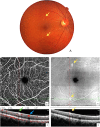Reply to Editorial: Interpretation of OCT and fundus findings in COVID-19 patients in recent Lancet publication
- PMID: 33239764
- PMCID: PMC7687980
- DOI: 10.1038/s41433-020-01283-2
Reply to Editorial: Interpretation of OCT and fundus findings in COVID-19 patients in recent Lancet publication
Conflict of interest statement
The authors declare that they have no conflict of interest.
Figures



Comment on
-
Retinal findings in patients with COVID-19.Lancet. 2020 May 23;395(10237):1610. doi: 10.1016/S0140-6736(20)31014-X. Epub 2020 May 12. Lancet. 2020. PMID: 32405105 Free PMC article. No abstract available.
References
-
- Landecho MF, Yuste JR, Gándara E, Sunsundegui P, Alcaide AB, García-Layana A. COVID-19 retinal microangiopathy as an in vivo biomarker of systemic vascular disease? J Intern Med. 2020. 10.1111/joim.13156. - PubMed
Publication types
MeSH terms
LinkOut - more resources
Full Text Sources
Medical

